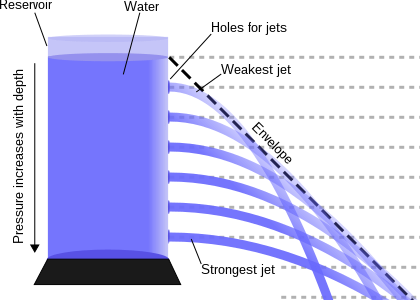Fluid Mechanics Help
I would like to describe the Torricelli's law at the level of A level Physics (i.e. with no prior knowledge to Bernoulli's equation and having no knowledge of pressure energy).
The law states that the speed of efflux, v, of a fluid through a sharp-edged hole at the bottom of a tank filled to a depth h is the same as the speed that a body (in this case a drop of water) would acquire in falling freely from a height h, i.e. , where g is the acceleration due to gravity.
, where g is the acceleration due to gravity.

Is there an alternative way to derive/explain this result other than using conventional Bernoulli's equation?
Thanks in advance.
The law states that the speed of efflux, v, of a fluid through a sharp-edged hole at the bottom of a tank filled to a depth h is the same as the speed that a body (in this case a drop of water) would acquire in falling freely from a height h, i.e.
 , where g is the acceleration due to gravity.
, where g is the acceleration due to gravity. 
Is there an alternative way to derive/explain this result other than using conventional Bernoulli's equation?
Thanks in advance.
Can you not derive it directly from the conservation of energy? For every unit volume of water leaving the tank, the water level in the tank drops. Thus the tank has lost some gravitational potential energy, and produced some kinetic energy, and the tank might be thought of as a device that converts energy in this way.
Equating the energy input with the energy output should give you the desired relation.
This is not entirely surprising because Bernoulli's equation is based on energy conservation.
Equating the energy input with the energy output should give you the desired relation.
This is not entirely surprising because Bernoulli's equation is based on energy conservation.
(edited 7 years ago)
Original post by mik1a
Can you not derive it directly from the conservation of energy? For every unit volume of water leaving the tank, the water level in the tank drops. Thus the tank has lost some gravitational potential energy, and produced some kinetic energy, and the tank might be thought of as a device that converts energy in this way.
Equating the energy input with the energy output should give you the desired relation.
This is not entirely surprising because Bernoulli's equation is based on energy conservation.
Equating the energy input with the energy output should give you the desired relation.
This is not entirely surprising because Bernoulli's equation is based on energy conservation.
Thank you so much. Following your argument, I could come up with the following tedious proof.
@lawlieto Here is another proof to the relation.
Posted from TSR Mobile
(edited 7 years ago)
Original post by tangotangopapa2
Thank you so much. Following your argument, I could come up with the following tedious proof.
@lawlieto Here is another proof to the relation.
Posted from TSR Mobile
@lawlieto Here is another proof to the relation.
Posted from TSR Mobile
Thank you
 it actually makes sense now
it actually makes sense nowQuick Reply
Related discussions
- mechanical or aerospace engineering!!!!!
- Aerospace engineering or Mechanical engineering
- Mechanical or aerospace engineering
- Mechanical Engineering Question Papers
- Aeronautical & Aerospace Engineering
- A guide to selecting your third year engineering modules
- Imperial MSc Advanced Mechanical Engineering Students, Applicants & Offer Holders
- Chemistry vs chemical engineering
- Chemical engineering or pharmacy
- Mechanical Engineering or Chemical Engineering?
- Aerodynamics masters degree
- Choosing a maths degree
- Elective Modules at Bath Chemical Engineering
- MSc Statistics Part Time
- Top 10 Tips for Engineering Students: My 1st Year
- Help with personal statement for chemical engineering
- MSc Statistics Acceptance Part-time
- UCL Civil Engineering Applicants 2019 Entry
- Aerospace engineering
- Aeronautics and astronautics or mechanical engineering?




